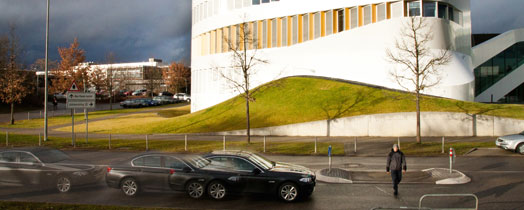Research initiative presents new traffic technologies for cities

Drivers have to be ready to react quickly to the unexpected, especially in busy traffic. For Fraunhofer IAO project manager Frederik Diederichs, the same principle applies to driver assistance systems:
“In the future, assistance systems will have to be aware of what drivers are about to do before they actually do it. To help us develop more intuitive systems, we expanded Fraunhofer IAO’s Vehicle Interaction Lab especially for UR:BAN. We also developed an algorithm for recognizing intentions,” says Diederichs. This new algorithm was installed in a BMW research vehicle and will also be on display when the initiative presents its project results.
Event motto: Making driving through the city of the future safe, efficient and stress-free
As four years of research activities draw to a close, the results will be showcased as part of an official final presentation to be held in Düsseldorf on October 7 and 8, 2015. This event will give some 300 guests the chance to spend two days getting acquainted with the latest technologies and ingenious systems and to speak directly with the experts.
In addition to talks and exhibitions, the event will offer a wide range of driving demonstrations to showcase the new technologies. Researchers from each of UR:BAN’s three project areas will present a vast array of exhibits as well as some 50 vehicle demonstrators.
Members of the Cognitive Assistance project team will host live demonstrations of new systems designed to help in everyday city traffic situations, such as oncoming traffic at bottlenecks, changing lanes in tight spaces, and using emergency measures to avoid collisions with pedestrians and cyclists. The complexity of city driving calls for reliable recognition of all surrounding road users. And for the first time, this also includes recognition of likely pedestrian behavior.
One of the highlights of the Networked Traffic System project presentation will be the traffic light assistance function for use under real traffic conditions. Here, crossing an intersection becomes either a partly automated process or one in which the driver is given recommendations for how best to cross. Numerous test vehicles will bring the various functions to life – from the intersection pilot to the phased traffic lights assistant and the delay assistant.
Work in the Human Factors in Traffic project area focused on the various ways people interact with city traffic. New methods and systems were developed to research this aspect of human behavior. Based on drivers’ head movements, for instance, a system can detect early on what they are likely to do next, thereby helping them master the challenges of city driving.
UR:BAN is the abbreviation of the research initiative’s German name, which translates as “Urban space: User-oriented assistance systems and network management”. A total of 31 partners from the automotive and supplier industry, electronics and software companies, universities, research institutions and cities have been collaborating to develop new driver assistance and traffic management systems for use in cities. The research initiative’s budget was 80 million euros and half of that funding was provided by the German Federal Ministry for Economic Affairs and Energy.
Contact:
Frederik Diederichs
Human Factors Engineering
Fraunhofer IAO
Nobelstraße 12
70569 Stuttgart, Germany
Phone: +49 711 970-2266
E-Mail: frederik.diederichs@iao.fraunhofer.de
https://www.iao.fraunhofer.de/lang-en/about-us/press-and-media/1243-improving-sa…
http://www.urban-online.org
Media Contact
All latest news from the category: Transportation and Logistics
This field deals with all spatial and time-related activities involved in bridging the gap between goods and people, including their restructuring. This begins with the supplier and follows each stage of the operational value chain to product delivery and concludes with product disposal and recycling.
innovations-report provides informative reports and articles on such topics as traffic telematics, toll collection, traffic management systems, route planning, high-speed rail (Transrapid), traffic infrastructures, air safety, transport technologies, transport logistics, production logistics and mobility.
Newest articles

First-of-its-kind study uses remote sensing to monitor plastic debris in rivers and lakes
Remote sensing creates a cost-effective solution to monitoring plastic pollution. A first-of-its-kind study from researchers at the University of Minnesota Twin Cities shows how remote sensing can help monitor and…

Laser-based artificial neuron mimics nerve cell functions at lightning speed
With a processing speed a billion times faster than nature, chip-based laser neuron could help advance AI tasks such as pattern recognition and sequence prediction. Researchers have developed a laser-based…

Optimising the processing of plastic waste
Just one look in the yellow bin reveals a colourful jumble of different types of plastic. However, the purer and more uniform plastic waste is, the easier it is to…



